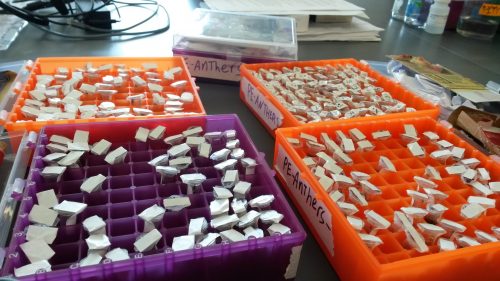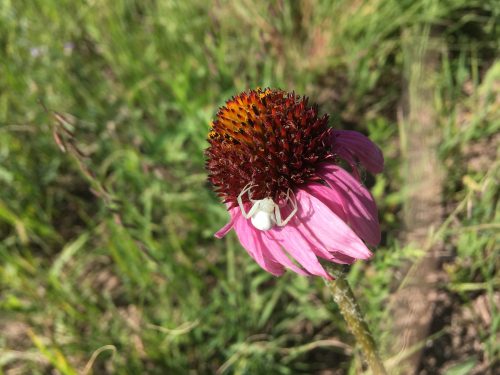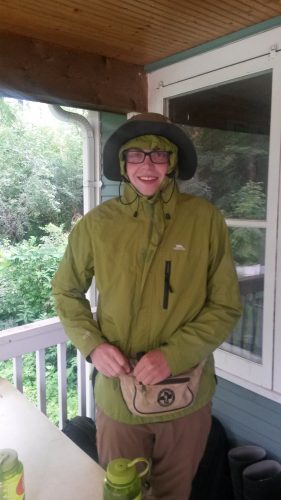|
|
This year in experimental plot 2, we measured pollinator visitation rates, per visit pollen removal, and per visit pollen deposition across common pollinator taxa to provide insight into pollination failure in Echinacea. We collected male and female phase floret samples from 183 Echinacea head observations conducted from July 9th to the July 31st, 2018. The pollinator taxa included in analysis were Andrena (N=18), Augochlorella (N=9), male Melissodes (N=53), small black bees (N=59), and unvisited heads used as environmental controls (N=30). Using light microscopy, we then quantified the number of pollen grains in these samples to determine how much pollen an individual of each taxon removes and deposits per visit. We found that the composite specialist Andrena rudbeckiae removes more grains of pollen per visit than the other common pollinator taxa in the study area; namely, male Melissodes sp., Augochlorella sp., and ‘small black bees,’ a wide taxonomic group comprising a variety of species mostly in the Halictidae. Pollen limitation in the population could be driven by frequent male Melissodes sp. visitation late in the season; based on the per visit removal of male Melissodes sp. and number of visits observed in this study. These results combine to contribute to our understanding of pollination failure and pollen limitation in small fragmented flowering plant populations.
 Mean pollen count of male phase floret samples after visitation compared across pollinator taxa Start year: (Official Experiment) 2018
Location: Experimental plot 2 at Hegg Lake WMA
Overlaps with: ExPt2
Physical specimens: 183 Echinacea heads in egg cartons
Data collected: Contact ZZ, EJ, or JLI for access to their data
Product (to come): Zeke Zelman’s Senior Thesis at Wooster College, 2019
Team members who worked on this project include: Zeke Zelman, Evan Jackson, and Jennifer Ison (2018)
“When life deals us cards
Make everything taste like it is salt
Then you come through like the sweetener you are
To bring the bitter taste to a halt”
Ariana Grande, in the song “Sweetener” off of her latest album Sweetener (2018).
Greetings from the College of Wooster, or Team Echinacea East
This summer I helped conduct research about the differences in pollen removal and deposition (a measure of pollinator efficiency) across different taxa of solitary bees that visited Echinacea flowers, out at P2 (with Evan, Mia, and Jennifer Ison). In order to quantify pollen removal we collected anthers (the male part of the flower that presents pollen) before a bee visited and again after the visit; we suspended the anthers in water. In order to quantify the number of pollen grains in each sample. But what to do with these samples?
 Here are all the sweet anther samples! In order to quantify the number of pollen grains present in each sample I first break apart and shake up the anthers, to try to get the pollen evenly distributed in the solution; then I count a small amount of this pollen solution on a hemocytometer under a microscope (a hemocytometer is a sort of microscope slide with a grid that is used to count red blood cells in blood; I use it to count pollen particles in water).
 Here’s the hemocytometer all loaded up with sweet pollen to count! Now that the summer field season is over I’ve been able to spend quite a bit of time counting pollen. While I’ve been counting pollen I’ve been listening to music on my roommate’s portable speaker. Mostly I’ve been listening to Ariana Grande’s new album Sweetener. The title track which opens this flog post speaks directly to the relationship that I have developed with the act of counting pollen. It is the sweetener to my life. I struggle to leave the lab each night; wanting to get just a little more of that sweet taste of pollen counting. It brings the bitter taste of college life to a halt. I don’t know what it is about pollen counting that I like so much. Is it the repetitiveness of it? The simplicity? The repetition? It’s impossible to say. All that I know for sure is that I really hope that everyone can experience the sweetness that counting pollen brings to my life.
P.S. I really hope I find something to fill the void that will be left in my existence once I run out of pollen to count (I only have 340 samples or so, and I’m more than half way through them).
Thanks
Hi flog,
On Saturday morning, some of the roost went out to breakfast at the traveler’s inn in Alexandria. We had coffee and eggs, and pancakes and discussed pies at great length. After breakfast walked to the local bakery and looked at baked goods, but decided against getting a pie, or any other baked goods. Next we walked through Alexandria’s bustling downtown to the nice Juicery and got very fancy juice with apples and charcoal and celery.
In the afternoon we went to the Tesoro across the street and filled up inner tubes for floating, and bought firewood.
For dinner Kristen, made avocado pasta.
At night we drove to Glenwood and had a fire in the park. We made s’mores threw around the Frisbee and talked about our summer research experience.
On Sunday a few of us went floating on the Long Prairie River. Despite the warm weather I started to get cold towards the end and was happy to get out of the water and warm up in the sun on the black tar road.
After floating we went to Zabar’s and had dinner. The food was good, I think the many letter zed’s made it even more delicious.
After dinner we watched an art film, some vine compilations and a few episodes of Seinfeld.
I’ve had a great summer and am immensely grateful for the opportunity I’ve had to do research here.
Hi flog,
Friday night we watched “The Truman Show” starring Jim Carrey. Since then the roost has been fighting the feeling that our existence is all part of a reality TV show….
 Kristen bought an HDMI cord, so that the roost could watch movies such as, “The Truman Show”  Mia saw this beautiful bumblebee visiting a rose this morning. Cameras are everywhere. This morning me, Mia and Evan went out to Hegg Lake and observed bee visits as part of our study on pollinator efficiency, nicknamed “Pollen in the Bank,” (we call it pollen in the bank, since the bees make “withdrawals” and “deposits” from the pollen on the flower). This morning we observed five small black bees and removed anthers and styles before and after each visit. But where were the cameras? Were the bees actors?
Mia pulled styles from her hand crosses, which aim to see how many grains of pollen are needed to fertilize a single Echinacea floret. One of the styles from Mia’s hand-crosses was shriveled, which probably means that this style was fertilized. Or pretended to be?
While we were waiting for bees we found the cover to Andy’s visor (handheld electronic data recorder). An exciting plot twist?
Back at the roost, we ate corn instead of eggs. Andy, and Mia had friends visit from out of town. We visited Will’s puppy, Shadow. A friendly puppy going through teething? Or a trained actor meant to manipulate us for entertainment.
Andy and Anne made two toll-house pies (giant chocolate chip cookies; and product placement?)
Thanks
Hi flog,
I would like to summarize the day from the perspective of my apartment’s egg consumption (we cooked up about 20 eggs today).
This morning me and Mia went out to Hegg lake to finish collecting data from Friday’s experiment on male fitness, and prepare for next week’s male fitness experiment (named: The big event 2: electric bugaloo). While we were there, Mia found a bird’s nest in the grass full of tiny chicks. They were very cute, so we chose to leave them alone rather than eat them. Once we finished, we went back to the roost, where I ate eggs for lunch (3 eggs down).
 The bird’s nest at P2.  Mia found a spider hanging out on an Echinacea flower. It’s probably not a very good pollinator. After lunch we played card games and Brigid made a beautiful chocolate cake (six more eggs down).
We decided it was too nice of a day to stay inside, so in the afternoon we went to Lake Carlos state park, to swim and play games, such as volleyball, and Kan jam (a Frisbee throwing game). We found out that Kristen played volleyball in high school, and Will’s overhand serve is hard to defend; also I can sometimes throw a Frisbee. We did not eat any eggs, while at the lake.
In the evening we returned to the roost. I made a stir fry with vegetables, chicken and 2 scrambled eggs.
I do not know what happened to the remaining 9 eggs (I’m sure they were put to good use); regardless I enjoyed a relaxing Saturday, with a perfect mix of Echinacea, team bonding, Frisbee, and eggs. Surely a good team eats eggs together (dietary restrictions allowing).
Hi Flog
This morning we split up to do task forces. I worked with some people to finish phenology (what was flowering and when) in plot one. Afterward, we planned to start more work out at Hegg Lake but no sooner had we arrived, then we were driven back to the farm by thunder, lightning, and rain.
On our way back we picked up Michael who had prudently protected himself from the storm by crouching in a ditch in “lightning position.” For those who may not know; lightning position is a special crouch that makes you completely immune to any danger associated with lightning or any other electrical Armageddon. To attain the lightning position, take a deep breath, tap your heels together three times, cover your ears and crouch down with your knees facing outwards and your butt not touching your heels. Next, remain in this position for the duration of the storm, which if it lasts for more than a few minutes, will give you a killer lower body workout.
The theory behind Lightning position is that, because you are low to the ground you won’t be struck by lightning directly; and if lightning strikes near you the electricity will travel through the ground and delicately remove your pants; without stopping your heart. However, if you were in a normal crouch a nearby lightning strike could travel through the ground and then straight up your body; stopping your heart, without bothering about your pants at all.
After safely returning to the farm, we had a productive morning learning how to identify small solitary bees. Around 11 AM Amy Waananen’s advisors visited, and promptly identified all the bees in the house, down to species from across the room.
 Andy, prepared for both rain and mosquitos After lunch, the sun broke through the clouds and we were able to go out to an experimental plot at Hegg Lake. This plot was planted by the Echinacea project in 2006 and has provided the project with valuable research opportunities ever since, especially since it started flowering in recent years. Because it is an experimental plot researcher cut off all the flowering heads at the end of the season. This summer Dr. Jennifer Ison is conducting a study on how different types of native bees contribute to the male fitness (seeds sired) of Echinacea. This study requires only about 400 flowering plants, however, the plot did especially well this year and had over 800 flowering plants. Since conducting the study on all 800 plants (over 1800 flower heads; one plant had 15 heads) is not feasible, we were forced to cut the heads off of 300 randomly chosen plants sooner rather than later.
Video Jul 03, 4 24 21 PM
After we cut as many heads as we could for the day, we returned to the farm and planned to finish cutting flowers tomorrow.
While uploading data, Riley asked a provocative question:
If you have an Agapostemon in your hand, what is in your eye?
Upon request, I decided to tweak the lyrics to the popular song “Boys” by Charli XCX so that it is about bees. Here it is: (I encourage you to listen to the original song, both for comparison, and enjoyment).
I was busy thinking about beesX3
I was busy dreaming ‘bout beesX3
Head is spinning looking at beesX3
I need that Agapostemon to visit me on a Friday
And I need those small black bees to wake me up on a Monday
That Augochlorella can come over on Tuesday day
I want Andrena, I want ‘em all
But if they don’t visit I’m all alone yeah, I’m looking out at views of the prairie
Those rolling grasslands, and ponds.
Didn’t take a picture
I’m sorry that I missed that Stipa search (also called porcupine grass), I wish I had a better excuse like I had to fix a visor (a handheld electronic data collector) problem;
But I was busy thinking ‘bout beesX3
Head is spinning watching them beesX3
Don’t be mad, don’t be mad at me,
Darling, I can’t stop it
Even if I wanted
Don’t be mad, don’t be mad at me
Missed that Stipa searching I was miles away
Don’t be mad not like I had a choice
I was busy thinking ‘bout beesX3
I was busy dreaming ‘bout bees bees bee’ees
Head is spinning looking for bees.
Echinacea Project 2018
Biology, College of Wooster 2018
Research Interests
I am interested in studying how different species of bees could have different effects on the fitness of flowering plants in the Prairie. More broadly I am interested in learning more about the pollination biology, and the prairie, and how both relater to conservation efforts and agriculture.
Statement
I am from Bennington, Vermont. I’m looking forward to spending some time in Minnesota. I haven’t had much experience studying plants, but I’m excited to learn. In my free time I like to to: play ultimate Frisbee, run, read, watch TV, hike, cross-country ski, etc.

|
|









